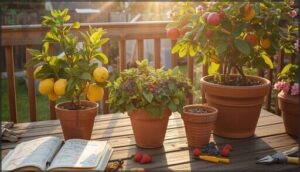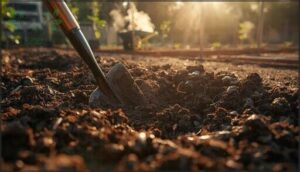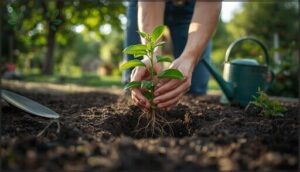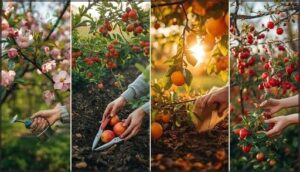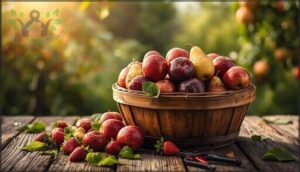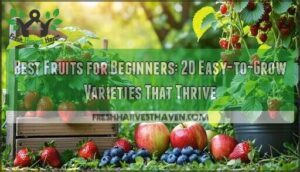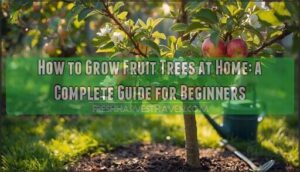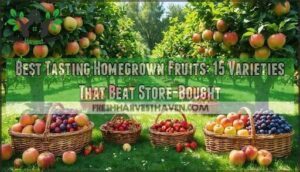This site is supported by our readers. We may earn a commission, at no cost to you, if you purchase through links.
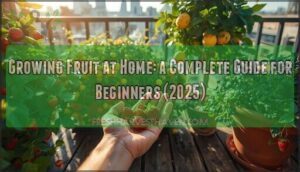
Modern dwarf varieties and container-friendly plants have transformed fruit cultivation from a farm-scale endeavor into an accessible backyard project. The key lies in matching the right plants to your specific conditions—your climate zone, available space, and commitment level.
Once you understand these fundamentals, you’ll discover that harvesting your own fruit isn’t just possible—it’s one of the most rewarding experiences in home gardening.
Table Of Contents
Key Takeaways
- You can successfully grow fruit in small spaces like balconies or windowsills by choosing dwarf varieties and container-friendly plants that match your specific hardiness zone and available sunlight.
- Proper soil preparation, including adding organic amendments for drainage and positioning plants for 8+ hours of direct sun, sets the foundation for healthy fruit production before you ever plant.
- Regular year-round maintenance—including late winter pruning, early spring fertilizing, weekly pest monitoring, and deep watering to 12-18 inches—keeps your fruit plants productive and prevents common problems.
- Harvesting at peak ripeness based on color shifts and firmness, then using proper storage methods like refrigeration or freezing, maximizes the flavor and extends the usability of your homegrown fruit for months.
Choosing The Right Fruit for Your Garden
Your first step in growing fruit at home is picking the right plants for your space and climate. Not every fruit thrives in every location, so you’ll need to match your choices to your hardiness zone, available sunlight, and growing conditions.
Let’s walk through how to assess your climate, choose suitable varieties, and find beginner-friendly options that set you up for success.
Assessing Your Local Climate and Hardiness Zone
Why do some fruit trees thrive in your neighbor’s yard but struggle in yours? Understanding your hardiness zone and local climate is the foundation of successful home gardening. The USDA plant hardiness zones help you match fruits to your region’s coldest winter temperatures.
Climate adaptation requires considering:
- Hardiness zones: Your zone determines which fruit trees survive winter
- Chilling hours: Temperate fruits need cold periods for dormancy
- Heat requirements: Growing degree hours affect fruit development timing
- Microclimates impact: Your garden’s specific conditions can shift frost dates
- Climate trends: Warming patterns influence fruit gardening success
Gardening tips for beginners: check microclimates within your space, as they create warmer or cooler pockets that affect growing fruit at home. Windbreaks are useful because they can protect up to 20 times their height in distance.
Selecting Suitable Fruit Varieties (Trees, Bushes, Vines)
Once you’ve confirmed your hardiness zone, you’ll face the exciting question: trees, bushes, or vines? Each category offers unique advantages for fruit gardening. Dwarf varieties occupy 40–60% less space than full-sized trees, perfect for compact yards. Berry bushes like blueberries thrive in acidic soils with pH 4.5–5.2. Consider pollination needs—apples require cross-pollinators within 100 feet, while peaches don’t. Disease resistance matters too; ‘Freedom’ apples show near-zero fire blight infection. Fruit plants, in general, require successful pollen transfer to produce fruit.
| Category | Space Requirements | Time to Production |
|---|---|---|
| Dwarf Trees | 8–12 feet spacing | 3–4 years |
| Berry Bushes | 4–6 feet spacing | 2–4 years |
| Grape Vines | 6–10 feet spacing | 2–3 years |
| Standard Trees | 16–25 feet spacing | 6–8 years |
Chill hours greatly impact fruit cultivation success in temperate climates.
High-Yield and Beginner-Friendly Fruits
You’ll want fruits that deliver impressive harvests without demanding expert care. Strawberries, blueberries, and blackberries top the beginner-friendly list—blackberry plants can yield 10–20 pounds per season, while blueberry bushes produce 2–6 pounds yearly.
Peach trees thrive in zones 5–9, offering 66–132 pounds at maturity. Cherry tomatoes and snap peas round out your productive options, with success rates exceeding 80% for first-time growers.
Indoor and Container-Friendly Options
Limited garden space shouldn’t stop you from growing fruits at home. Dwarf varieties like Meyer lemon and dwarf fig thrive indoors with proper container gardening techniques.
Container Requirements for Indoor Fruit Trees:
- Container size matters: Use 7–20 gallon pots for healthy root systems
- Light requirements: Provide 8–12 hours daily with LED grow lights
- Pollination needs: Choose self-pollinating varieties for successful fruiting
Small space gardening delivers real harvests—Meyer lemons produce up to 50 fruits annually with attentive fruit tree care and pest control.
Preparing Soil and Garden Space
Before you plant a single fruit tree or berry bush, you need to give your garden a solid foundation. Think of soil preparation like setting the stage—get it right, and your plants will thrive with less fuss down the road.
Soil preparation is the foundation—get it right, and your fruit plants will thrive with far less effort
Let’s walk through the key steps to create the ideal growing environment for your homegrown fruit.
Improving Soil Structure and Drainage
Good soil drainage is like giving your fruit plants room to breathe underground. Start by adding organic amendments such as compost or aged manure to loosen compacted soil and improve water flow.
You can also use cover crops like winter rye or try raised beds if your garden stays too wet.
These simple soil preparation steps will help your plants develop strong, healthy roots.
Planning Sun Exposure and Garden Layout
Most fruit trees need at least 8 hours of direct sunlight daily to produce abundant harvests. When planning your garden layout, consider these key factors for sunlight maximization and microclimate creation:
- Orient rows north–south for consistent sun distribution throughout the day
- Place taller trees on the north side to prevent seasonal shading of shorter plants
- Use espalier techniques against south-facing walls in small space gardening
- Track sun patterns before planting to identify the best locations
Using Raised Beds and Containers
When space is tight or your native soil disappoints, raised beds and containers open new possibilities for growing your own food. Studies show raised beds can triple yields compared to poor ground soil, while proper container soil mixtures double production over bagged blends.
Bed design matters—build up at least 6 inches for drainage, refresh annually, and match container size to your climate adaptation needs for consistent yield efficiency.
Planting Fruit Trees, Bushes, and Vines
Once your soil is ready, it’s time to get your hands dirty and put those plants in the ground. The way you plant and the timing you choose can make or break your fruit-growing success.
Let’s walk through the essentials of planting techniques, spacing, and early care to give your fruit plants the best possible start.
Best Planting Times for Different Fruits
Timing makes all the difference when you’re planting fruit. Your success depends on matching the right season to what you’re growing. Here’s what works best:
- Deciduous fruit trees (apples, cherries, peaches) thrive when planted in early spring or fall, giving roots time to settle before extreme weather hits
- Berry bushes like strawberries and blueberries prefer early spring planting in most regions
- Citrus timing varies—spring works best in temperate zones, while late winter suits tropical areas
Proper Planting Techniques for Success
Once you’ve chosen your planting time, the real work begins. Dig a hole at least three feet wide for fruit trees—your roots need room to spread. Place the root ball so it sits level with the ground, keeping the graft union 1-3 inches above soil. Water deeply right after planting, then add three inches of mulch around the base to lock in moisture.
Spacing and Training Young Plants
Proper spacing prevents years of overcrowding headaches down the road. Rootstock influence determines how much room your fruit trees actually need—dwarf apples work with 8-10 feet between plants, while standard varieties demand 30-35 feet. Here’s your spacing guide for orchard health:
- Dwarf spacing: 8-10 feet for apples, 8 feet for pears
- Semi-dwarf trees: 12-15 feet apart
- Stone fruits: 12-18 feet for peaches and plums
- Cherries: 20 feet for sour, 30 feet for sweet varieties
- Training systems: Use central-leader for vertical growth or open-center for spreading shapes
Berry bush maintenance and vine support require trellises with 4-inch mesh spacing. Start pruning techniques early—head your central leader 24-30 inches above ground and select 3-4 scaffold branches for proper fruit tree care.
Watering Guidelines for New Plantings
Once your trees are settled in, water becomes your most important tool. New plantings need daily attention for the first two weeks—think 5 gallons three times weekly for best root moisture. Deep saturation reaching 18-24 inches prevents shallow roots, while drip efficiency delivers 90% water-use effectiveness. Mulch retention cuts evaporation dramatically.
Monitor strategies include checking soil 60 cm down:
| Timeline | Frequency |
|---|---|
| Weeks 1-2 | Daily watering |
| Weeks 3-12 | Every 2-3 days |
| After 3 months | Weekly (adjust for weather) |
| Peak summer | 27 gallons per 27 sq ft |
Caring for Fruit Plants Year-Round
Once your fruit plants are in the ground, the real work begins. Keeping them healthy throughout the year means staying on top of a few essential tasks that change with the seasons.
Let’s walk through the key practices that’ll help your plants thrive and produce abundant fruit.
Pruning Methods for Healthy Growth
You’ll want to prune your fruit trees annually during late winter, after the worst cold has passed. Use thinning cuts to remove entire branches at their base, which maintains your tree’s size without triggering wild new growth.
For thicker branches over two inches, make three cuts to prevent bark tearing. This yearly habit boosts your harvest and keeps plants healthy for years ahead.
Fertilizing and Nutrient Management
Feed your fruit trees between April and mid-May, before buds break open. Soil testing reveals exactly what your plants need—most fruit trees prefer a pH between 6.0 and 6.5.
Apply 10-10-10 fertilizer at one pound per inch of trunk diameter for stone fruits, but stop fertilizing after July.
Watch for deficiency symptoms like yellowing leaves or small fruit, which signal micronutrient gaps organic options can address.
Pest and Disease Monitoring and Control
Check your plants weekly for early warning signs. Spotted wing drosophila tops the pest list at 21%, with codling moths and Japanese beetles close behind.
Scout for disease during dormancy, too. Use pheromone traps and spray schedules timed to pink bud and petal fall stages.
IPM strategies combining biological controls like lady beetles with selective sprays protect your fruit trees and berry plants while keeping beneficial insects thriving.
Watering and Mulching Best Practices
Keeping your soil moist, not soaked, makes all the difference in fruit yield. Aim for 1–1.5 inches of water weekly during the growing season, watering deeply to reach 12 inches down.
Drip systems boost resource conservation by 30–50%. Layer organic mulch materials 6–8 inches thick around plants to cut moisture loss by 70%, but keep it away from trunks to prevent rot.
Harvesting, Storing, and Using Homegrown Fruit
After all your hard work tending your fruit plants, harvest day is one of the most rewarding moments in home gardening. Knowing when and how to pick your fruit makes all the difference in flavor and freshness.
Let’s walk through the essentials of harvesting, storing, and making the most of your homegrown bounty.
Identifying Peak Harvest Times
Knowing when your fruit is truly ripe makes all the difference in fruit production. For apples and pears, watch for background color shifts from green to yellow-green, and check if they detach easily at the stem. Ripeness indicators like firmness, aroma, and sweetness matter too.
Harvest windows vary by region—strawberries ripen June through early July, while blueberries peak late July to mid-September in northern zones.
Techniques for Safe and Efficient Harvesting
Once your fruit is ready, harvesting with care protects both you and your crop. Clean tools before you start—sanitized scissors and pruners reduce pathogen risks. For injury prevention and less fatigue, ergonomic tools make a real difference in home gardening.
Follow these essentials for safe fruit cultivation techniques:
- Wash hands thoroughly before picking
- Use clean, food-grade containers only
- Handle fruit gently to avoid bruising or splits
Short- and Long-Term Fruit Storage Solutions
After harvesting, your freshly picked treasures need the right environment to stay delicious. Refrigerators at 41°F or below work for most homegrown produce—berries last 2-7 days while apples can hold 1-12 months with ideal temperature and humidity control.
Fruit-specific needs matter: stone fruits ripen at room temperature first, then chill. Storage containers and ethylene management prevent premature spoiling, making home gardening rewards last longer.
Preserving and Enjoying Your Homegrown Fruit
Your homegrown produce deserves preservation methods that lock in flavor and nutrients. Freezing fruits maintains nearly all their original goodness—studies show no significant nutrient loss compared to fresh.
Canning methods and drying techniques extend your harvest for months, while jams & jellies capture summer’s sweetness year-round.
These gardening tips and tricks transform your fruit-growing success into lasting culinary rewards.
Frequently Asked Questions (FAQs)
How do I protect fruit from birds and wildlife?
You’ll need layered pest management strategies to guard your harvest. Bird netting offers near-complete protection when properly installed, while fruit cages defend against birds and small mammals. Exclusion fences stop deer effectively.
Can I grow fruit in partial shade conditions?
Yes, though sunlight requirements differ by variety. Shade-tolerant varieties like blueberries, currants, and hardy kiwis adapt well.
Expect photosynthesis reduction, affecting fruit quality. Compensate through soil amendments, adaptive pruning, and proper berry gardening techniques for home gardening success despite planting instructions suggesting full sun.
What are common pollination requirements for fruit trees?
Most fruit trees require cross-pollination from compatible varieties planted within 50-100 feet. Bees are primary pollinators.
However, many peaches and nectarines are self-pollinating, needing no pollination partner for successful fruit production.
How do I winterize fruit plants in cold climates?
Protect roots with two to four inches of mulch depth after hard frosts. Use tree wraps for trunks, practice dormant pruning in late winter, make sure to pre-winter watering, and add container insulation for potted fruits.
When should I replace aging or unproductive fruit plants?
Consider replacement when yield decline exceeds 50%, disease impact proves untreatable, or economic viability diminishes after peak lifespan limits.
Variety upgrades offer improved resistance and productivity, making strategic orchard management decisions worthwhile for sustained home gardening success.
Conclusion
Think of your first harvest like opening a door you didn’t know existed—suddenly, your kitchen counter holds fruit that traveled only footsteps, not thousands of miles.
Growing fruit at home transforms patience into sweetness, effort into abundance. You’ve learned the essentials: choosing wisely, planting carefully, nurturing consistently.
Now comes the best part—watching those first blossoms become something you can actually taste.
Your garden is waiting. Start small, start today.

